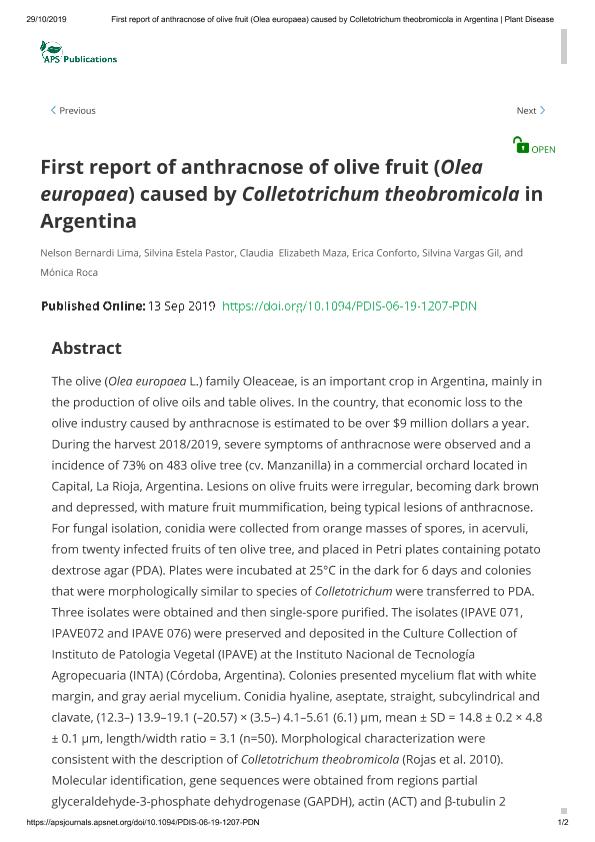Mostrar el registro sencillo del ítem
dc.contributor.author
Bernardi Lima, Nelson

dc.contributor.author
Pastor, Silvina Estela

dc.contributor.author
Maza, Claudia Elizabeth
dc.contributor.author
Conforto, Erica Cinthia

dc.contributor.author
Vargas Gil, Silvina

dc.contributor.author
Roca, Monica Esther María

dc.date.available
2021-02-25T12:33:53Z
dc.date.issued
2019-11
dc.identifier.citation
Bernardi Lima, Nelson; Pastor, Silvina Estela; Maza, Claudia Elizabeth; Conforto, Erica Cinthia; Vargas Gil, Silvina; et al.; First report of anthracnose of olive fruit ( Olea europaea ) caused by Colletotrichum theobromicola in Argentina; American Phytopathological Society; Plant Disease; 104; 2; 11-2019; 1-2
dc.identifier.issn
0191-2917
dc.identifier.uri
http://hdl.handle.net/11336/126546
dc.description.abstract
The olive (Olea europaea L.) family Oleaceae, is an important crop in Argentina, mainly in the production of olive oils and table olives. In the country, that economic loss to the olive industry caused by anthracnose is estimated to be over $9 million dollars a year. During the harvest 2018/2019, severe symptoms of anthracnose were observed and a incidence of 73% on 483 olive tree (cv. Manzanilla) in a commercial orchard located in Capital, La Rioja, Argentina. Lesions on olive fruits were irregular, becoming dark brown and depressed, with mature fruit mummification, being typical lesions of anthracnose. For fungal isolation, conidia were collected from orange masses of spores, in acervuli, from twenty infected fruits of ten olive tree, and placed in Petri plates containing potato dextrose agar (PDA). Plates were incubated at 25°C in the dark for 6 days and colonies that were morphologically similar to species of Colletotrichum were transferred to PDA. Three isolates were obtained and then single-spore purified. The isolates (IPAVE 071, IPAVE072 and IPAVE 076) were preserved and deposited in the Culture Collection of Instituto de Patologia Vegetal (IPAVE) at the Instituto Nacional de Tecnología Agropecuaria (INTA) (Córdoba, Argentina). Colonies presented mycelium flat with white margin, and gray aerial mycelium. Conidia hyaline, aseptate, straight, subcylindrical and clavate, (12.3?) 13.9?19.1 (?20.57) × (3.5?) 4.1?5.61 (6.1) µm, mean ± SD = 14.8 ± 0.2 × 4.8 ± 0.1 µm, length/width ratio = 3.1 (n=50). Morphological characterization were consistent with the description of Colletotrichum theobromicola (Rojas et al. 2010). Molecular identification, gene sequences were obtained from regions partial glyceraldehyde-3-phosphate dehydrogenase (GAPDH), actin (ACT) and β-tubulin 2 (TUB2), were amplified by PCR (Weir et al. 2012) and sequenced. Sequences obtained in this study were deposited in GenBank, isolates IPAVE 071, 072 and 076, respectively (Accessions nos. GAPDH: MN027902, MN027903, MN027904; ACT: MN027899, MN027900, MN027901 and TUB2: MN027905, MN027906, MN027907). A phylogenetic analysis based on Bayesian inference was performed, which shows that the isolated fungi belong to the C. theobromicola clade. Pathogenicity tests were conducted on ten olive fruits cv. Manzanilla. Fruits were surface disinfested by immersing them in a 1% sodium hypochlorite solution for 1 min, washed three times with sterile distilled water and dried on sterilized filter paper. The fruits were wounded at the center by inserting a sterile needle (to a depth of 2 mm) and inoculated with six microliters of conidial suspension (1 × 106 conidia ml-1). Control fruits were inoculates whit sterilized water. Fruits were incubated at 25 ± 1°C for 48h in semi-hermetic plastic containers to ensure a relative high humidity (>90%). The fruits were maintained at the 25 ± 1°C (12 h light/12 h dark). Typical anthracnose symptoms were observed after 10 days. C. theobromicola was successfully reisolated from symptomatic olive fruits to fulfill Koch´s postulates. C. theobromicola was previously reported on olive causing anthracnose in Australia (Schena et al., 2014). This is the first occurrence of Colletotrichum theobromicola in Argentina and the first report causing anthracnose of olive fruit (Olea europaea L.).
dc.format
application/pdf
dc.language.iso
eng
dc.publisher
American Phytopathological Society

dc.rights
info:eu-repo/semantics/openAccess
dc.rights.uri
https://creativecommons.org/licenses/by-nc-sa/2.5/ar/
dc.subject
OLEA EUROPAEA
dc.subject
ANTHRACNOSE
dc.subject
COLLETOTRICHUM THEOBROMICOLA
dc.subject.classification
Agronomía, reproducción y protección de plantas

dc.subject.classification
Agricultura, Silvicultura y Pesca

dc.subject.classification
CIENCIAS AGRÍCOLAS

dc.title
First report of anthracnose of olive fruit ( Olea europaea ) caused by Colletotrichum theobromicola in Argentina
dc.type
info:eu-repo/semantics/article
dc.type
info:ar-repo/semantics/artículo
dc.type
info:eu-repo/semantics/publishedVersion
dc.date.updated
2020-12-15T14:16:42Z
dc.journal.volume
104
dc.journal.number
2
dc.journal.pagination
1-2
dc.journal.pais
Estados Unidos

dc.journal.ciudad
Saint Paul
dc.description.fil
Fil: Bernardi Lima, Nelson. Unidad de Fitopatologia y Modernizacion Agricola; Argentina. Instituto Nacional de Tecnologia Agropecuaria. Centro de Investigaciones Agropecuarias. Unidad de Fitopatologia y Modelizacion Agricola. - Consejo Nacional de Investigaciones Cientificas y Tecnicas. Centro Cientifico Tecnologico Conicet - Cordoba. Unidad de Fitopatologia y Modelizacion Agricola.; Argentina
dc.description.fil
Fil: Pastor, Silvina Estela. Instituto Nacional de Tecnología Agropecuaria. Centro de Investigaciones Agropecuarias. Instituto de Patología Vegetal; Argentina
dc.description.fil
Fil: Maza, Claudia Elizabeth. Instituto Nacional de Tecnología Agropecuaria; Argentina
dc.description.fil
Fil: Conforto, Erica Cinthia. Instituto Nacional de Tecnología Agropecuaria. Centro de Investigaciones Agropecuarias. Instituto de Patología Vegetal; Argentina
dc.description.fil
Fil: Vargas Gil, Silvina. Unidad de Fitopatologia y Modernizacion Agricola; Argentina. Instituto Nacional de Tecnologia Agropecuaria. Centro de Investigaciones Agropecuarias. Unidad de Fitopatologia y Modelizacion Agricola. - Consejo Nacional de Investigaciones Cientificas y Tecnicas. Centro Cientifico Tecnologico Conicet - Cordoba. Unidad de Fitopatologia y Modelizacion Agricola.; Argentina
dc.description.fil
Fil: Roca, Monica Esther María. Servicio Nacional de Sanidad y Calidad Agroalimentaria; Argentina
dc.journal.title
Plant Disease

dc.relation.alternativeid
info:eu-repo/semantics/altIdentifier/url/https://apsjournals.apsnet.org/doi/10.1094/PDIS-06-19-1207-PDN
dc.relation.alternativeid
info:eu-repo/semantics/altIdentifier/doi/https://doi.org/10.1094/PDIS-06-19-1207-PDN
Archivos asociados
